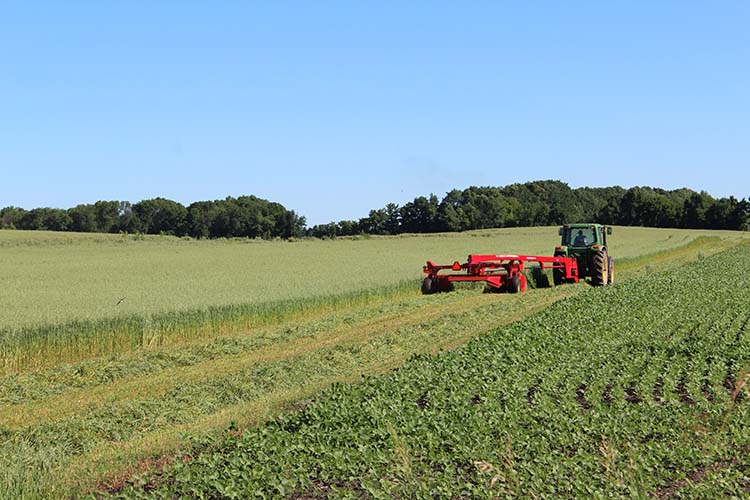The information below has been supplied by dairy marketers and other industry organizations. It has not been edited, verified, or endorsed by Hoard’s Dairyman.

Forage inventories remain strained going into 2023, and although for some areas drought conditions have eased this spring, a large portion of the US is still facing a precipitation deficit. According to the US Drought Monitor, 57 percent of winter wheat and 62 percent of spring wheat areas are currently experiencing drought. Following a tough growing year, this dry spring may be the only chance to raise a forage supply to alleviate feed stress on farms. In times like these, it’s even more critical to maximize the forage harvested. And the fermentation process is a major component of optimizing forage to get through the year.
“When harvesting this forage for silage, decreasing fermentation shrink will not only yield higher quality silage but will also ensure less forage is degraded in the fermentation process,” shares Katie Raver, Rock River Laboratory animal nutrition and field support specialist. Raver offers some key insights into optimizing silage during the ongoing drought.
Dry Matter (DM) loss due to fermentation shrink is often calculated as forage harvested versus the amount of forage available at feed out. This can be difficult to accurately track, however, it is good to make efforts to do so. In addition, there are tools available, such as equations to estimate fermentation shrink based on the nutritive analysis, that can help track fermentation shrink and make sure money is not being left on the silage pad.
“Small grain silage fermentation shrink estimates in the Rock River Laboratory database range from one percent to over ten percent with an average of 3.5 percent,” says Raver. “This has a huge economic impact, and for producers struggling to supply enough forage for their operation this is dry matter they can’t afford to lose.”
She continues to share that for every 100 acres harvested [assuming five DM tons harvested per acre], one percent of fermentation shrink is equivalent to one acre of feed lost.
Harvesting silage
Harvesting silage too dry can make it difficult to pack - leaving more opportunity for air to remain in the silage and increasing the fermentation difficulty. Some inoculants do contain oxygen scavengers, which can help make the most of this silage, even if it did get chopped later than desired. Harvesting too early or not allowing proper wilt time can cause the silage to be put up too wet.
Raver explains, “Wet silages typically have higher dry matter loss and are more susceptible to a butyric fermentation. Silages that have butyric acid present are indicative of a clostridial fermentation, and may be difficult to feed due to potential health impacts or palatability issues.”
She also recommends avoiding soil contamination. “Although spring forages are at higher risk for ash contamination, careful harvest practices can help decrease this risk.,” she says. High ash can make it difficult to achieve a desirable fermentation.
As silage is harvested and put up, silage inoculants and preservatives can help protect the investment. Every 60 acres harvested equates to approximately $40,000 worth of forage, and the replacement cost of this forage is likely much higher in many parts of the world due to the forage shortage. Inoculants and preservatives can help achieve a desirable fermentation, decrease time to a stable pH, and help decrease the risks associated with poor fermentation - such as mycotoxin or clostridial growth, which can contribute to DM losses.
Putting up silage
Make sure silage is densely packed. Once silage is harvested, packing density is key to achieving maximum silage yield, and improper packing can lead to increased shrink numbers.
“Ensure enough pack weight is applied per the amount of silage being added to the pile,” warns Raver. “Once the pile is made, cover the feed quickly with an adequate silage plastic to help minimize spoilage of silage on the top layers”. Patching holes in the silage cover as they arise is also important to make every bit of forage harvested count.
Feedout
Once silages are harvested and packed, ensuring silage has had enough time to ferment is critical. Opening the pile early can result in extremely large DM losses.
Raver adds, “For those in a forage deficit and relying on this feed to get by, it can be extremely tempting to crack open that pile early, however, this can significantly increase feed losses.”
Harvest can be a particularly stressful time for operations of every size. There are many aspects to manage. However, ensuring each step is done correctly will maximize the amount and the quality of feed put up. As a southern Texas resident, Raver can attest, “Although proper silage management is always critical, in years of forage deficit this becomes even more important as we look to ensure feed availability throughout the year.”
Founded in 1976, Rock River Laboratory is a family-owned laboratory network that provides production assistance to the agricultural industry through the use of advanced diagnostic systems, progressive techniques, and research-supported analyses. Employing a team of top specialists in their respective fields, Rock River Laboratory provides accurate, cost-effective, and timely analytical results to customers worldwide, while featuring unsurpassed customer service.





